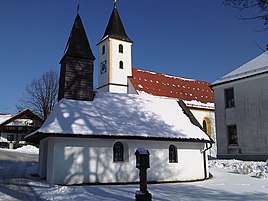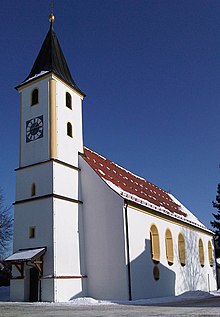Heilbrunn (Wiesenfelden)
|
Heilbrunn
Community Wiesenfelden
Coordinates: 49 ° 2 ′ 49 ″ N , 12 ° 33 ′ 58 ″ E
|
||
|---|---|---|
| Height : | 639 m above sea level NN | |
| Residents : | 136 (May 25 1987) | |
| Incorporation : | 1st January 1971 | |
| Postal code : | 94344 | |
| Area code : | 09966 | |
|
Location of Heilbrunn in Bavaria |
||
|
In front the Chapel of Grace, in the background the pilgrimage church of St. Magdalena
|
||
Heilbrunn is a church village and a place in the municipality of Wiesenfelden in the Lower Bavarian district of Straubing-Bogen .
history
From 1818 the place was a separate political municipality in the district court Mitterfels , from 1839 in the district court Bogen of the district office Bogen , the forerunner of the former district Bogen . The northern municipality of Geraszell was incorporated in 1926. Heilbrunn and Geraszell have had a common mayor since time immemorial. Heilbrunn has always been part of Wiesenfelden in terms of postal services, while Geraszell received postal services from Zinzenzell until the early 1980s. Heilbrunn had its own school, which since 1969 had belonged to the Wiesenfelden School Association, which was then newly founded. At the 1961 census, the community Heilbrunn had 317 inhabitants, the village 69. On January 1, 1971, the community Heilbrunn with all districts, the church village Heilbrunn and the villages Geraszell, Großviecht and Hötzelsdorf , were incorporated into the community Wiesenfelden.
location
Heilbrunn is located about two kilometers northeast of Wiesenfelden and 3 km south of Zinzenzell on the state road 2648.
Pilgrimage
Heilbrunn was previously known for its Chapel of Grace with its own pilgrimage, which originated in the middle of the 17th century. According to tradition, a man with gout named Adam Kurz found an image of Mary from a miraculous spring that he had buried during the Thirty Years' War and was healed.
Attractions
Pilgrimage Church of St. Magdalena
The pilgrimage church of St. Magdalena was built in 1674 and later received a neo-Gothic interior, which was removed again. The ceiling painting shows the beginning of the pilgrimage, the wonderful healing of the man suffering from gout.
History and architecture
At the end of the 12th century, the name of the hamlet Viecht (now Großviecht) appears in the early writings of the Oberalteich monastery. There is talk of a courtyard to which a small chapel belonged. A note about the existence of a chapel dates from 1648. After the source of grace was found, the influx of pilgrims increased, which in 1674 led to a large church being built. The church building is a simple baroque complex. The choir ends with five octagonal sides, is delimited by the re-entrant arch and has a flat ceiling and three window axes. The tower is presented on the west side, its superstructure consists of two floors, which are separated from the nave. The exterior renovation began in 1986, followed by the interior of the church in 1987, and in 1988 the figural decorations were given their present appearance.
In 1885 the furnishings from the time it was built had become ruinous and were completely replaced. Neo-Romanesque forms were chosen and new color windows donated. The high altar was adorned with a painting of St. Magdalena from 1850. It was flanked by two figures and is considered lost. Wall and ceiling paintings gave the room a closed appearance.
In 1961 the interior was completely redesigned. With the exception of the chairs, pictures and figures, the furnishings were removed, and the windows were replaced with simple glass. The ceiling painting, which has been excellently restored today, has been preserved from the painting. A crucifixion group was attached to the east wall of the choir and a matching figure of St. John was acquired for the life-size crucifix and the painful Mother of God from around 1740. The figures on the pulpit date from around 1675, the Way of the Cross from 1884. In 1947 the gallery was enlarged.
In the 1980s, the church was fundamentally renovated and the entire shell was completely redesigned in terms of stucco and walls. The chancel was redesigned and a new heating system was installed.
Chapel of Grace Frauenbrünnl
The Frauenbrünnl chapel was built around 1654 . It contains an altar from the 18th century and the miraculous image, a carved Madonna and Child, as well as many votive tablets and the healing fountain. In 1648 the Bishop of Regensburg requested a report on the "newly invented" fountain. By this time the worship of a source of grace had already begun.
societies
- Heilbrunn volunteer fire brigade V.
- Warrior and soldier comradeship Heilbrunn
- Oldtimerfreunde Heilbrunn e. V.
literature
- Susanne Hansen (ed.): The German places of pilgrimage. Pattloch Verlag, Augsburg, 2nd edition 1991, ISBN 3-629-00005-3 .
- Pilgrimage Curatie Heilbrunn (Ed.): Pilgrimage Church of St. Magdalena, Heilbrunn. Stolz Druck GmbH, Mitterfels 1988.
Web links
- Heilbrunn in the location database of the Bavarian State Library Online . Bavarian State Library
Individual evidence
- ↑ BayernAtlas , Topographic Map 1: 25000
- ↑ Bavarian State Office for Statistics and Data Processing (Ed.): Official local directory for Bavaria, territorial status: May 25, 1987 . Issue 450 of the articles on Bavaria's statistics. Munich November 1991, DNB 94240937X , p. 241 ( digitized version ).
- ↑ a b Wilhelm Volkert (Ed.): Handbook of the Bavarian offices, communities and courts 1799–1980 . CH Beck, Munich 1983, ISBN 3-406-09669-7 , p. 437 .
- ↑ Bavarian State Statistical Office (ed.): Official city directory for Bavaria, territorial status on October 1, 1964 with statistical information from the 1961 census . Issue 260 of the articles on Bavaria's statistics. Munich 1964, DNB 453660959 , Section II, Sp. 276 ( digitized version ).


